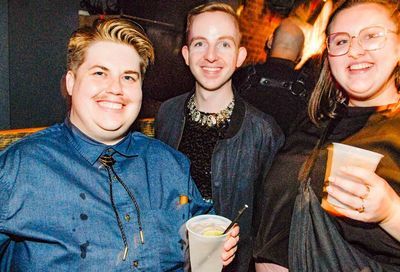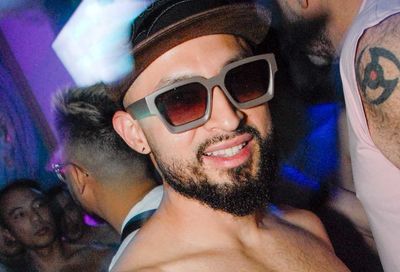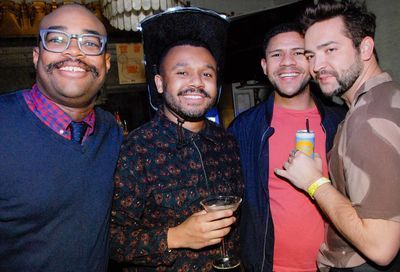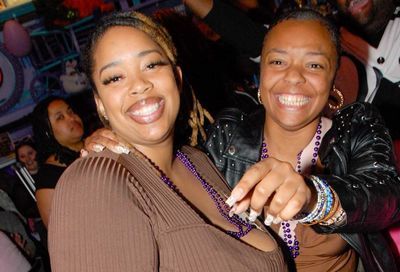Mais Oui, Montréal!
A travel guide to Canada's gay-friendly city
 |
Many Washingtonians aren’t aware that the world’s second largest French-speaking city is only an hour’s flight from National. Or that 11 million tourists visit that island city every year to enjoy its delicious food, friendly atmosphere, and great shopping. Quelle surprise. Montréal also has rapidly become one of the most gay-friendly places on Earth and where the basic human rights of all people are respected.
With an estimated gay population of 350,000 in the metropolitan area, about 800,000 people lined the route of the city’s gay pride parade last summer, the biggest turnout yet. It was an amazing sight: people who could easily pass as grandparents sitting on lawn chairs waving rainbow flags, straight couples with children in strollers, multi-generational families, and a wonderfully diverse crowd of GLBT persons all out to celebrate the city’s vibrant gay community — or at least to revel in the biggest gay party the city had ever mounted.
The most exciting thing in gay Montréal’s future is hosting Gay Games VII in the summer of 2006. Although some controversy has emerged in recent weeks, Montreal’s gay community is already electrified. Mark Tewksbury, an Olympic gold medalist in swimming at Barcelona, a national celebrity and now the co-chair of the Gay Games board of directors, said the Gay Games “are a chance to show the world what a truly civilized, modern society looks like.” Tewksbury takes obvious pride as the eyes of the world focus on, among other things, his nation’s movement toward same sex marriage.
Dorval International Airport, soon to be renamed in honor of Pierre Trudeau, is only a 20-minute taxi ride to the city’s gay core. Known as the Village, it’s located in the eastern portion of Ville Marie, Montréal’s original borough, akin to an arrondissement in Paris, which includes the historic area, Vieux Montréal. Now one of the largest gay neighborhoods in the world, this pulsing strip on rue Sainte Catherine East became the city’s queer center beginning in the 1970s.
But gay life had its start in Montréal well before that. The Colonial Baths, long a meeting place for gays, opened in 1914. The first recorded gay establishment in North America was Moise Tellier’s apple and cake shop, dating from 1869 on what is now rue St. Antoine, where men came to rendezvous (and a bit more, it’s told).
One of the best things about accommodations in the Village is their convenience to the rest of the city. Most everything is within walking distance and with three Metro stops located in or near the Village, quick transportation elsewhere is never far away. Beaudry, the most centrally located of the stations, proudly bears the rainbow colors as part of its design.
With 25 gay and lesbian accommodations to choose from in the Village, finding a great place to stay is almost always possible. Room rates for the guesthouses mentioned here, which vary by season, may be obtained from their websites.
My favorite guesthouse is Accommodation Montréal Gay (1607 rue Montcalm, 514-524-8789, www.accommodationmontrealgay.com), run by handsome former Mountie Jacques Godbout. It’s one of the friendliest places in the Village and the service is superb. This three-story historic inn has both a bed and breakfast (or gite in French) and several fully-equipped one-bedroom apartments for those who prefer having a kitchen and living room.
Among the B&Bs most popular with Washington visitors is La Conciergerie (1019 rue St. Herbert, 514-289-9297, www.laconciergerie.ca) several blocks south of the Village. It has taken over a couple of full-sized row houses, which provides room for a rooftop sundeck and an interior hot tub. You may find it more difficult to get a reservation here unless you book early.
A couple recently opened historic guesthouses are well appointed and very friendly. Alexandre-Logan (1631 Alexandre Desève, 514-598-0555, www.alexandrelogan.com) is charming and inviting, while just a few houses down the same street, Alcazar (at #1589, 514-223-2622, www.alcazarmontreal.com) boasts one of the few area pools (albeit a small one).
 |
With 5,000 restaurants, Montréal is truly a gourmand’s dream. And while the Village isn’t particularly known for its restaurants, there are a few excellent choices offering delicious cuisine at very reasonable prices, especially with the favorable currency exchange — prices noted below have been converted to their approximate U.S. equivalency and are subject to change.
Most restaurants will provide a menu in English if you ask, but remember that in French, an entrée is the first course. Also, places displaying a sign in the front window reading “Apportez votre vin” allow you to bring your own wine — a great cost saver. Most restaurants along rue Prince Arthur northwest of the village allow this and I’ve never been charged a corkage fee.
Seemingly the most popular Village place for the gay crowd is the Saloon (1333 rue Ste. Catherine) where owner Philip Demers offers an affordable menu drawing on Italian, Asian and Mexican influences. Both chicken teriyaki and grilled salmon are good picks for main courses, which range from $7 to $12. With a D.J. spinning tunes most nights, this place rocks, so don’t come here expecting quiet conversation.
A better place for a tête-à -tête can be found across the street at Piccolo Diavolo (1336 Ste. Catherine), a more formal Italian eatery with an accomplished kitchen under the direction of Chef Jacques Faucher. Start with escargot atop a spicy blend of vegetables and herbs and crispy julienned potatoes. Main courses of cannelloni with veal and salmon coated in polenta with mushrooms are both outstanding. Main courses go for $9 to $17.
French cuisine at moderate prices may be found at Resto Bisous (1327 Ste. Catherine). Salmon tartare with a complex sauce enlivened by horseradish is an excellent starter. Moules et frites (mussels and fries), are exceptional. Steamed in a blend of white wine, butter and Pernod, these fresh Prince Edward Island mollusks are truly inspired. With main courses between $12 and $18, Bisous is an excellent value.
It’s impossible to avoid the buzz associated with Chef Normand Laprise’s Toqué (3842 rue St. Denis) located on the plateau above the Village. Here world-renowned cuisine is served in an atmosphere of restrained elegance. While arguably the pinnacle of Montreal haut cuisine, the experience is only moderately impressive. With dinner for two with wine approaching $200 I expected artistry, although an appetizer of scallops bathed in strawberry water and vodka and topped with a foamy mousse of tarragon oil and preserved lemon was truly inspired. Main courses are $18-26.
Montréal has a thriving Jewish community of 100,000 and one of its many contributions to the city is its food. Bagels here are said to be the finest in the world, and after exhaustive sampling, this seems to be true. They’re different from New York bagels in that they contain eggs, making them less spongy, and they’re baked in wood-burning ovens. Perhaps the best of all are at two locations of The Bagel Shop (158 and 263 rue St. Viateur West) where, since 1957, they’re found hot-from-the-oven 24-hours a day. It’s a bit of a schlep from the Village, but well worth it.
If you have a car, there is another type of Montréal bagel to try that you’ve never seen anywhere else. It’s U-shaped and filled with cheese, really more like a blintz. For this you’ll have to go off the island to the near-northern suburb of Laval. There at Pâtisserie Chomedey (4627 rue Samson West) you’ll experience this uniquely-Montréal treat, the Laval bagel.
There is so much night life in Montreal one hardly knows where to begin. In the Village and adjacent to it are at least 16 standard gay bars, four bars with nude dancers, five gay saunas (or bath houses, with nine more elsewhere in the city), eight gay clubs, and a couple after-hours clubs. Most are located on rue Ste. Catherine or steps away on a cross street.
The bars stay open until 3 a.m., and the after-hours clubs are open until noon. Information about all of these establishments is available in the Montréal and Québec edition of Fun Maps (www.funmaps.com) or in Fugues (www.fugues.com), a free weekly publication that contains some English language sections, available everywhere in the city.
One of the nicest places to hang out, have an afternoon drink, and cool off in its small roof-deck pool is Sky Pub (1474 Ste. Catherine). Its street-level lounge, open to the sidewalk, is a great spot for watching the constant parade of people walking up and down Ste. Catherine. Later in the evening, Sky is a hot dance club very popular with the locals.
If you’re looking for a more serious cruising scene, try Aigle Noir (Black Eagle, 1315 St. Catherine) or Le Stud (leather bar, 1812 Ste. Catherine). And if dancing nude boys get your blood flowing, there is no shortage of venues either. With a reputation for beefy, muscular guys, Campus (1111 Ste. Catherine) is the most popular. Its friendly danseurs will chat you up between their performances to entice you to experience a lap dance in a private booth. Another place with an emphasis more on youth is Taboo (1950 de Maisonneuve), where the guys are younger and less muscle-bound.
Montreal is a great town for antiquing, with clusters of shops along rue Amherst near the Village, among others, and a larger concentration on rue Notre Dame a short taxi ride west of Old Montréal. Aside from antiques, browse the boutiques along Boulevard Saint Laurent and rue Saint Denis, parallel north-south streets, for clothing, kitchenware, food, and of course wine.
One of my favorite strips is along Avenue du Mont-Royal running east-west well north of the Village. Here in a less gentrified area are charming row houses, fascinating shops, some of the city’s hottest bistros, and European-style fruitieres, patisseries, and gourmet food stores.
 |
Okay, you’ve hit the night spots, dined to excess, shopped until exceeding your capacity to carry the stuff, and now you want to see what else tourists come here for. A great place to start is Old Montréal and the old port. Both located within easy walking distance of the Village, this is where you can literally see the foundations of Ville Marie, the initial settlement here dating from 1642. Underneath the Museum of Archaeology and History (350 Place Royale) you’ll see the excavated settlement.
The narrow cobblestone streets of the old city immediately transport you to Europe. Here quaint shops, galleries, and cafés look lifted right out of Paris or provincial cities. If you’re the romantic type, take a slow carriage ride through Old Montréal starting in front of Notre Dame Basilica on Place D’Armes. The interior of the massive church has a unique floor that slopes downward as you approach the high altar giving worshipers in the back a more unrestricted view of the services.
The old port area, adjacent to Old Montréal, has a wonderful clock tower that you may climb for a birds-eye view of the old city and the fast-flowing St. Lawrence River.
A climb to the highest natural point in the city, Mount Royal, is de rigueur. Accessible from several starting points, you’ll walk up wide, winding paths through a giant park designed by noted landscape architect Frederick Law Olmstead, of Central Park and U.S. Capitol grounds fame. The park includes a large lake and the most of gorgeous views of the city’s skyline from several vantage points.
As with any large city, Montréal has a few drawbacks. The most serious, of course, is its winter climate with temperatures often dipping far, far below zero Fahrenheit, despite being on the same latitude as Geneva and Venice. Perhaps it’s this forbidding climate and 4 p.m. winter sunsets that give Montréalers their zest for life, especially in the warmer months. Meanwhile, an elaborate underground city with 30 kilometers of walkways linking 10 Metro stations, 60 buildings, 2,000 apartments, 200 restaurants, 1,700 boutiques, and two of the city’s four universities makes winter life a little easier.
Drivers in Montréal regularly exceed speed limits and run more red lights than I’ve seen anywhere. Crossing streets must be approached with great care. In order to protect the lives of pedestrians, red turns on right are strictly outlawed. And you’d never know that elsewhere in North America smoking is on the decline. Sometimes even outdoor spaces are thick with secondary smoke.
Far more positive things about Montréal, though, outweigh these climatic and cultural negatives. For instance, there’s one tree for every two inhabitants, miles of bike paths, great public transportation, and loads of annual festivals and events, including the renowned Montréal Jazz Festival and the Montréal World Film Festival.
When Montréal was constructing its underground Metro system, the vast amount of dirt displaced was used to create another island in the St. Lawrence River. Named ÃŽle Notre Dame, this mass of parkland features a floral garden, a grand prix circuit track, and the fabulous Casino de Montréal, formerly the French and Québec pavilion at Expo 67, when this city played host to the world’s fair. On adjacent ÃŽle Sainte Hélène (Metro: Jean-Drapeau) visit the impressive geodesic dome of the Biosphere and the armory at the island’s historic fort. The east end of the island is home to Québec’s largest amusement park, LaRonde, a Six Flags property that hosts an annual Gay Day.
Montréalers are quick to make eye contact which can easily be confused as cruising. What do you expect, though, from a society that greets acquaintances with a kiss on each cheek as opposed to a handshake from a distance of three feet. Don’t trust your gaydar too much here since style knows no rigid boundaries.
This is a place where families are truly important and where “family” includes the broadest possible definition of that term.
It’s remarkable in a city predominantly Roman Catholic that homosexuality and same sex marriage are being embraced not universally but certainly by the majority. Perhaps this is due to the relative youth of its population, as Montréal has more university-aged residents per capita than any other city in North America. But some of this acceptance surely comes from a broader Canadian attitude that treasures diversity more than in the U.S.
There’s always more to say about Montréal. It’s truly a feast for the senses for those open to adventure. If you’ve never been here it’s well worth your time and resources to experience it. If you haven’t been here in a while, it may be time to come back. It’s hard to imagine another opportunity to travel so little distance and so profoundly change one’s environment. Battered by tourist fears of terrorism in the airways and SARS (which never touched Québec), Montréal’s tourism has been badly lagging this year. With crowds down and the U.S. dollar strong, there may never have been a better time to visit our highly seductive and intriguing neighbor.
Support Metro Weekly’s Journalism
These are challenging times for news organizations. And yet it’s crucial we stay active and provide vital resources and information to both our local readers and the world. So won’t you please take a moment and consider supporting Metro Weekly with a membership? For as little as $5 a month, you can help ensure Metro Weekly magazine and MetroWeekly.com remain free, viable resources as we provide the best, most diverse, culturally-resonant LGBTQ coverage in both the D.C. region and around the world. Memberships come with exclusive perks and discounts, your own personal digital delivery of each week’s magazine (and an archive), access to our Member's Lounge when it launches this fall, and exclusive members-only items like Metro Weekly Membership Mugs and Tote Bags! Check out all our membership levels here and please join us today!





















